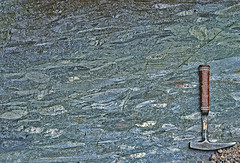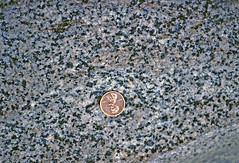 One type of metamorphic bedrock in Rock Creek Park is Laurel Formation.
One type of metamorphic bedrock in Rock Creek Park is Laurel Formation.
Photographer: Tony FlemingThe metamorphic bedrock in Rock Creek Park originated as marine sediment that accumulated in a deep trench next to a range of volcanic islands. Volcanic eruptions probably furnished much of the sediment. New evidence is emerging, indicating that many of these rocks are "pyroclastic" in origin—i.e., the product of fiery clouds of ash and rock fragments generated by catastrophic volcanic explosions.1 These deposits were subsequently buried, compressed into sedimentary rock, and then recrystallized under high temperature and pressure to form metasedimentary and metavolcanic rock (shorthand for metamorphosed sedimentary and volcanic rock), which was later thrust into its present position during the geologic events that caused the rise of the Appalachian Mountains.
 One type of igneous bedrock in Rock Creek Park is Kensington tonalite.
One type of igneous bedrock in Rock Creek Park is Kensington tonalite.
Photographer: Tony FlemingThe igneous bedrock in Rock Creek Park crystallized from magma deep below the surface of the earth; the hot magma filled cracks and voids in the surrounding rock as it rose upward. These igneous rocks have a coarse-grained texture with many large, visible crystals because they cooled slowly, deep below the surface of the earth as intrusive bodies. (In contrast, another kind of igneous rock—lava—cools rapidly at the earth’s surface, producing finer crystals. It is sometimes called extrusive igneous rock.)
Quartz veins at Rock Creek Park are a special kind of igneous rock formed from hot, silica-rich fluids circulating in the earth’s crust. Because its impact on vegetation is extremely different, we treat it separately from the park’s other intrusive igneous bedrock.
- 1. . 2008. Personal communication.


